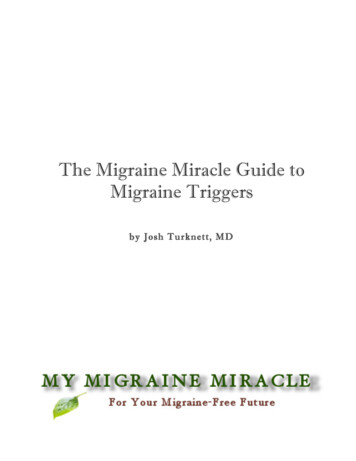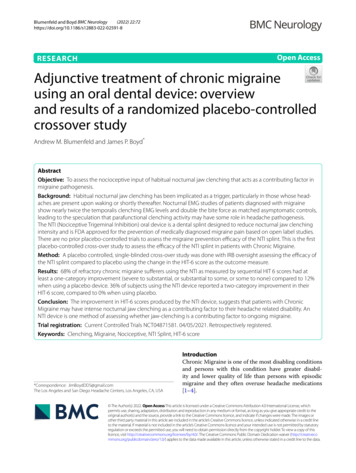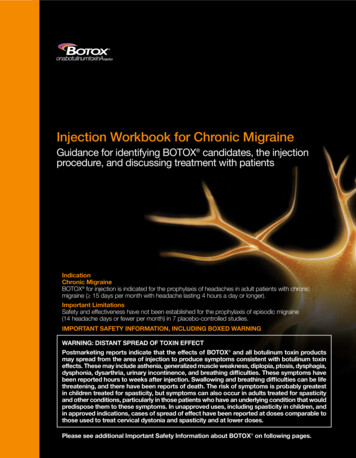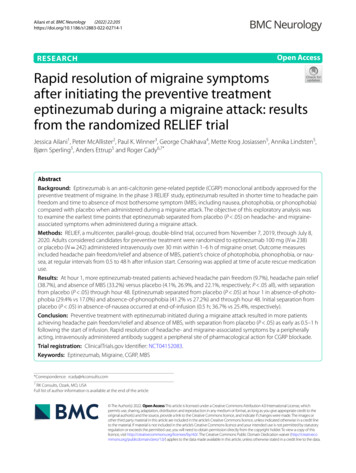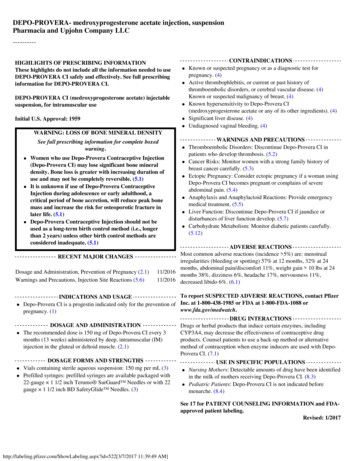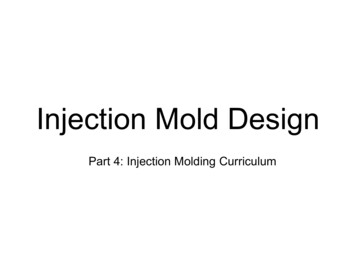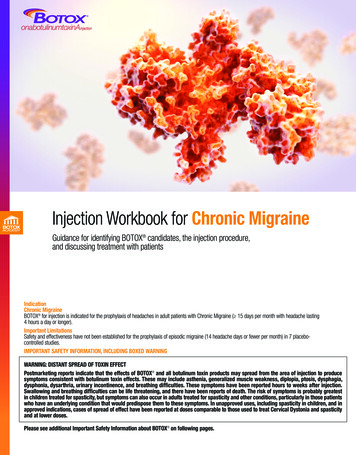
Transcription
Injection Workbook for Chronic MigraineGuidance for identifying BOTOX candidates, the injection procedure,and discussing treatment with patientsIndicationChronic MigraineBOTOX for injection is indicated for the prophylaxis of headaches in adult patients with Chronic Migraine ( 15 days per month with headache lasting4 hours a day or longer).Important LimitationsSafety and effectiveness have not been established for the prophylaxis of episodic migraine (14 headache days or fewer per month) in 7 placebocontrolled studies.IMPORTANT SAFETY INFORMATION, INCLUDING BOXED WARNINGWARNING: DISTANT SPREAD OF TOXIN EFFECTPostmarketing reports indicate that the effects of BOTOX and all botulinum toxin products may spread from the area of injection to producesymptoms consistent with botulinum toxin effects. These may include asthenia, generalized muscle weakness, diplopia, ptosis, dysphagia,dysphonia, dysarthria, urinary incontinence, and breathing difficulties. These symptoms have been reported hours to weeks after injection.Swallowing and breathing difficulties can be life threatening, and there have been reports of death. The risk of symptoms is probably greatestin children treated for spasticity, but symptoms can also occur in adults treated for spasticity and other conditions, particularly in those patientswho have an underlying condition that would predispose them to these symptoms. In unapproved uses, including spasticity in children, and inapproved indications, cases of spread of effect have been reported at doses comparable to those used to treat Cervical Dystonia and spasticityand at lower doses.Please see additional Important Safety Information about BOTOX on following pages.
BOTOX CMJobNumber:Prod Mgr:Client:Traffic Mgr:4hours or moreper day1. Uncover true headache frequency.3-5182285Getting to an appropriate diagnosisBrittany E.PU from 180327— Corrugator injections .22Headaches lastCount days when a headache lasted fewer than 4 hours due to successful acute treatment.2Anterior injections.18— Anatomy of the face and head .18Studio Artist:PREEMPT* Paradigm and BOTOX efficacy .12General injection considerations .17AD/Designer: Bret P8or more migrainedays per monthNOTES:Identifying BOTOX candidates .1015or more headachedays per monthOutput Scale: 100%Chronic Migraine is a distinct disease .8File Location: Studio-AestheticsChronic Migraine diagnosis .3Print PageSize:Table of contentsw 9" x h 11.5"Practical clinical criteria1,2Doc. Size:Take the next step in your education with this comprehensive guide to BOTOX injections. Review Chronic Migraine diagnosis,anatomical assessment, injection technique, patient dialogue, and more.125”Chronic Migraine diagnosisLive:Bleed:Introduction— Procerus injections .24— Occipitalis injections.322. Document headache frequency, severity, and disability.— Cervical paraspinal injections.343. Clearly communicate a diagnosis.Tips to efficiently administer BOTOX treatment in the office.46Resources available to patients .48Resources available to injectors and the office .49X Mechanical2Mech LiteIMPORTANT SAFETY INFORMATION (continued)CONTRAINDICATIONSBOTOX is contraindicated in the presence of infection at the proposed injection site(s) and in individuals with known hypersensitivity to any botulinumtoxin preparation or to any of the components in the formulation.“You haveChronic Migraine”Comp*PREEMPT Phase 3 REsearch Evaluating Migraine Prophylaxis Therapy.Validatedmeasurement tools5/5 : PMS144Patient assessment before injection .42Final Output:OrigMechPatient case studies.40Brand Lead:Revision #:Adverse events .38Intake forms7/2/18Headache diariesDate:— Trapezius injections.36Use visual cuesand open-endedquestions to facilitatepatient dialogueInjection WorkbookCover Update— Anatomy of the neck and head .30Ask aboutmigraine featuresTbldOPosterior injections .30Ask how headachesare affecting thepatient’s daily lifeDescription:— Temporalis injections.28Ask aboutheadache-freedaysQ/C Check:— Frontalis injections .26IMPORTANT SAFETY INFORMATION (continued)WARNINGS AND PRECAUTIONSLack of Interchangeability Between Botulinum Toxin ProductsThe potency Units of BOTOX are specific to the preparation and assay method utilized. They are not interchangeable with other preparationsof botulinum toxin products and, therefore, Units of biological activity of BOTOX cannot be compared to nor converted into Units of any otherbotulinum toxin products assessed with any other specific assay method.Please see additional Important Safety Information about BOTOX on following pages.3
Chronic Migraine diagnosisMany appropriate patients do not receive a Chronic Migraine diagnosis6-836%25%Possible reasons why clinicians don’t diagnose Chronic Migraine soonerDon’t see an urgent benefit to providing a patient with a specific diagnosisFeel documentation of a Chronic Migraine diagnosis is only required when seekingBOTOX prior authorizationChronic Migraine diagnosis ratefor patients who meet the criteriaand are seeing a specialist*Chronic Migraine diagnosis ratefor patients who meet the criteria andare seeing any healthcare professional†*Based on an epidemiological study of Chronic Migraine patients (n 200) who sought evaluation from a specialist.†Based on an epidemiological study of Chronic Migraine patients (n 512) who sought evaluation from a healthcare professional (specialist or non-specialist).May classify some migraines as tension-type headaches, leading to a diagnosis ofmixed headache disorder10Chronic Migraine patients are often diagnosed well after they’ve met criteria94 in 10Don’t see Chronic Migraine as physiologically distinct from other headache typesBOTOX patients don’t receive aformal Chronic Migraine diagnosisuntil their first treatment‡Based on claims data from 19,727 Chronic Migraine patients.‡IMPORTANT SAFETY INFORMATION (continued)WARNINGS AND PRECAUTIONS (continued)Spread of Toxin EffectSee Boxed Warning.No definitive serious adverse event reports of distant spread of toxin effect associated with BOTOX for Chronic Migraine at the labeled dose havebeen reported.4IMPORTANT SAFETY INFORMATION (continued)WARNINGS AND PRECAUTIONS (continued)Serious Adverse Reactions With Unapproved UseSerious adverse reactions, including excessive weakness, dysphagia, and aspiration pneumonia, with some adverse reactions associated with fatal outcomes, havebeen reported in patients who received BOTOX injections for unapproved uses. In these cases, the adverse reactions were not necessarily related to distant spreadof toxin, but may have resulted from the administration of BOTOX to the site of injection and/or adjacent structures. In several of the cases, patients had pre-existingdysphagia or other significant disabilities. There is insufficient information to identify factors associated with an increased risk for adverse reactions associated withthe unapproved uses of BOTOX . The safety and effectiveness of BOTOX for unapproved uses have not been established.Please see additional Important Safety Information about BOTOX on following pages.5
Chronic Migraine diagnosisWhy diagnose? Survey results among patients with varying conditionsshow that patients want to know1199%stated that they want tolearn about their condition*95Patients with both tension headache and migraine may not havemixed headache disorder1090%%feel that being well-informedwill have a positive effecton their treatments*Diagnosis can set the stage for a comprehensive management plan12,13Increases patient understanding about their diseaseof patients with disabling tensionheadaches actually had a form ofmigraine.* This may lead someclinicians to misclassify patients whoactually have Chronic Migraine*Based on a study of 432 patients.The nature of migraine attacks may obscure a patient’s true headacheand lead to a misdiagnosis144 to 72 iveTreatmentHighlights the importance of appropriate preventive treatment and managementof comorbidities/medication overuse5 to 60 minutes24 to 48 hoursA few hours todaysSupports discussions about Chronic Migraine-specific treatment options like BOTOX Prodrome*N 337 patients with various conditions.AuraHeadachePostdromeDuration of stage of headache/migrainePatients may not count dull headaches that may accompany postdrome as part of their headache day tally, because theyare less severe. This could lead to underdiagnosis of Chronic Migraine.14IMPORTANT SAFETY INFORMATION (continued)WARNINGS AND PRECAUTIONS (continued)Hypersensitivity ReactionsSerious and/or immediate hypersensitivity reactions have been reported. These reactions include anaphylaxis, serum sickness, urticaria, soft-tissue edema, anddyspnea. If such a reaction occurs, further injection of BOTOX should be discontinued and appropriate medical therapy immediately instituted. One fatal case ofanaphylaxis has been reported in which lidocaine was used as the diluent, and consequently the causal agent cannot be reliably determined.6IMPORTANT SAFETY INFORMATION (continued)WARNINGS AND PRECAUTIONS (continued)Increased Risk of Clinically Significant Effects With Pre-existing Neuromuscular DisordersIndividuals with peripheral motor neuropathic diseases, amyotrophic lateral sclerosis (ALS), or neuromuscular junction disorders (eg, myasthenia gravis or LambertEaton syndrome) should be monitored when given botulinum toxin. Patients with known or unrecognized neuromuscular disorders or neuromuscular junctiondisorders may be at increased risk of clinically significant effects including generalized muscle weakness, diplopia, ptosis, dysphonia, dysarthria, severe dysphagia,and respiratory compromise from therapeutic doses of BOTOX (see Warnings and Precautions).Please see additional Important Safety Information about BOTOX on following pages.7
Chronic Migraine is a distinct diseaseChronic Migraine is a clinically and physiologically distinct disease14-18Chronic Migraine is associated with persistent physiological changes22Episodic MigraineǁChronic MigraineAverage headache duration perattack (without medication)*38.8 hours65.1 hoursMIDAS Grade IV ( 21)†23.6%79.1%Visit emergency room*5.4% per year9.0% per .2%Obesity‡,§21.0%25.5%Associated structuralchanges in the brainPossibleLikely*Chronic Migraine n 499; episodic migraine n 8227.†MIDAS The Migraine Disability Assessment Test‡Chronic Migraine n 655; episodic migraine n 11,249.§Incidence of comorbidity.ǁEpisodic migraine is characterized by migraine patients who experience 0 to 14 headache days per month, some of which may be migraine.Physiological changes associated with Chronic Migraine include structural changes in the brain such as iron accumulation in theperiaqueductal gray matter. These changes can be shown in functional MRI imaging.22Cortical RegionsCortical Surface AreaCortical ThicknessVolumeA holistic examination of this distinct disease can help informChronic Migraine diagnosisEvaluate headache history beyond a 1 month to 3 months time frame20,21Encourage patients to include postdrome as part of their headache day count14Ask open-ended questions to uncover disability and comorbidities3Understand the persistent physiological changes associated with Chronic Migraine178These images are based on a functional imaging study of 120 people.22 The MRI images compare Chronic Migraine vs episodicmigraine patients, and were taken when they were not experiencing migraine.22 The study’s primary finding is that brain corticalsurface area, thickness, and regional volumes are accurate markers for classifying migraine patients as having Chronic Migrainevs episodic migraine.22IMPORTANT SAFETY INFORMATION (continued)WARNINGS AND PRECAUTIONS (continued)Dysphagia and Breathing DifficultiesTreatment with BOTOX and other botulinum toxin products can result in swallowing or breathing difficulties. Patients with pre-existing swallowing or breathingdifficulties may be more susceptible to these complications. In most cases, this is a consequence of weakening of muscles in the area of injection that are involved inbreathing or oropharyngeal muscles that control swallowing or breathing (see Boxed Warning).Please see additional Important Safety Information about BOTOX on following pages.9
Identifying BOTOX candidatesConsiderations when evaluating treatment plansPrevention may be an important part of a Chronic Migraine management plan. Aside from ensuring adequate prevention,a management plan may include optimizing acute medication use/limiting medication overuse, addressing comorbidconditions, and adjusting patient lifestyles (eg, diet, exercise, curbing caffeine overuse).12,13Your patients may already meet their insurance policy requirements forBOTOX treatmentMajority of lives require trialof 2 or fewer oral preventives23,*Treatment planning begins with a thorough history, which can include inquiry around these topics:77.5%9.7%Is the patientusing more acutemedications thanrecommended?What treatmentshas the patienttried with otherproviders?Is the patientmeetingtreatmentgoals?Is the patientre-tryinga preventivetreatmentat a differentdose?12.8%Is the patientfollowing his/herprescribedtreatment regimenas recommended?2 or fewer3 or moreN/AChronic Migraine patientshave tried3.9preventive treatmentson average (n 493)24Based on data covering 244,831,608 medical lives.Understanding oral preventive trial requirementsSome factors considered when determining adequate treatment trial include: Number of oral preventives needed Types of therapeutic classes Required duration of each treatment trial (if any) Whether medications with contraindications or intolerance concerns may count as a treatment trialCheck with individual payer policies for specific treatment trial requirements.*As of Q2 2015.IMPORTANT SAFETY INFORMATION (continued)WARNINGS AND PRECAUTIONS (continued)Human Albumin and Transmission of Viral DiseasesThis product contains albumin, a derivative of human blood. Based on effective donor screening and product manufacturing processes, it carries an extremely remoterisk for transmission of viral diseases and variant Creutzfeldt-Jakob disease (vCJD). There is a theoretical risk for transmission of Creutzfeldt-Jakob disease (CJD),but if that risk actually exists, the risk of transmission would also be considered extremely remote. No cases of transmission of viral diseases, CJD, or vCJD have everbeen identified for licensed albumin or albumin contained in other licensed products.ADVERSE REACTIONSAdverse reactions to BOTOX for injection are discussed in greater detail in the following sections: Boxed Warning, Contraindications, and Warnings and Precautions.10IMPORTANT SAFETY INFORMATION (continued)ADVERSE REACTIONS (continued)Chronic MigraineThe most frequently reported adverse reactions following injection of BOTOX for Chronic Migraine vs placebo include, respectively: neck pain (9% vs 3%), headache(5% vs 3%), eyelid ptosis (4% vs 1%), migraine (4% vs 3%), muscular weakness (4% vs 1%), musculoskeletal stiffness (4% vs 1%), bronchitis (3% vs 2%),injection-site pain (3% vs 2%), musculoskeletal pain (3% vs 1%), myalgia (3% vs 1%), facial paresis (2% vs 0%), hypertension (2% vs 1%), and muscle spasms(2% vs 1%).Severe worsening of migraine requiring hospitalization occurred in approximately 1% of BOTOX treated patients in study 1 and study 2, usually within the first weekafter treatment, compared with 0.3% of placebo-treated patients.Please see additional Important Safety Information about BOTOX on following pages.11
(Mean Change From BaseliHeadache Days/28 DayBOTOX efficacy was achieved followingthe proven PREEMPT ParadigmBOTOX (n 341)Placebo (n 338)-2a-4a-6a-8aaa-10-12Double-Blind PhasePatients on BOTOX had 8 to 9 fewer headache days and migraine/probable migrainedays per month compared with baseline (vs 6 to 7 days with placebo) at 24 weeks1,21,22Open-Label PhasePatients on BOTOX had 8 to 9 fewer headache days and migraine/probable migrainedays per month compared with baseline (vs 6 to 7 days with placebo) at 24 weeks1,25,26RESULTS FROM PREEMPT 11,25RESULTS FROM PREEMPT 42832364044485256BOTOX (n 341)Placebo (n 338)-2a-4P .05a-6a-8aaa-10-12Double-Blind PhaseOpen-Label Phase(Mean Change From Baseline)0Headache Days/28 Days*Headache Days/28 Days*0(Mean Change From Baseline)P .05-2BOTOX (n 347)Placebo (n 358)-4a-6-8-10P .05aaaaaa-12-14Double-Blind PhaseOpen-Label PhaseAfter week 24 all patientsreceived BOTOX After week 24 all patientsreceived BOTOX *A headache day was defined as a calendar day per 28 days with 4 continuous hours of headache.25*A headache day was defined as a calendar day per 28 days with 4 continuous hours of headache.26Study design: PREEMPT 1 and 2 were randomized, double-blind, placebo-controlled studies (N 1384) across 122 sites. Subjects included adult Chronic Migrainepatients not using any concurrent headache prophylaxis and, during a 28-day baseline period, had 15 headache days lasting 4 hours or more, with 50% beingmigraine/probable migraine. Patients were allowed to use acute headache treatments during Weekthe study. Primary end point was 24 weeks.1,25,26Study design: PREEMPT 1 and 2 were randomized, double-blind, placebo-controlled studies (N 1384) across 122 sites. Subjects included adult Chronic Migrainepatients not using any concurrent headache prophylaxis and, during a 28-day baseline period, had 15 headache days lasting 4 hours or more, with 50% beingmigraine/probable migraine. Patients were allowed to use acute headache treatments during the study. Primary end point was 24 weeks.1,25,26048121620242832364044485256(Mean Change From Baseline)0Headache Days/28 Days*-2In PREEMPT trials,BOTOX patients received at least 2 treatments, 12 weeks apart,to determine effectiveness (primary end point at 24 weeks).1BOTOX (n 347)Placebo (n 358)-4-6aP .05aIMPORTANT SAFETY INFORMATION (continued)ADVERSE REACTIONS (continued)-8aaaPostmarketing Experiencea area discussed in greater detail in Postmarketing Experience (Section 6.3 of theAdverse reactions that have been identifiedduringpostapprovaluseof BOTOX-10Prescribing Information).-12 of death, sometimes associated with dysphagia, pneumonia, and/or other significant debility or anaphylaxis, after treatmentThere have been spontaneous reports12-14The PREEMPT Paradigm calls for injections in 31 sites across 7 head/neck muscle areas,with a total dose of 155 Units.1Double-Blind PhaseOpen-Label PhaseIMPORTANT SAFETY INFORMATION (continued)ADVERSE REACTIONS (continued)Postmarketing Experience (continued)with botulinum toxin. There have also been reports of adverse events involving the cardiovascular system, including arrhythmia and myocardial infarction, some withfatal outcomes. Some of these patients had risk factors including cardiovascular disease. The exact relationship of these events to the botulinum toxin injection hasnot been established.Please see additional Important Safety Information about BOTOX on following pages.13
Responder rates for BOTOX patients in PREEMPTclinical trials50% reduction in headache days from baseline in each month at week 2475% reduction in headache days from baseline in each month at week 2425,2627,28BOTOX (N 341)a15%19%a16%26%b16% Placebo BOTOX PlaceboPlacebo BOTOX(N 347)(N 358)(N 347)(N 358)(N 338)bbaP .002P .002P NSPlacebo BOTOX (N 338) (N 341)P NS15%26%b% of Patients With a 75% Decrease From Baselinein Headache Days (Out of 100%)19%a% of Patients With a 75% Decrease From Baselinein Headache Days (Out of 100%)34%% of Patients With a 75% Decrease From Baselinein Headache Days (Out of 100%)34%% of Patients With a 75% Decrease From Baselinein Headache Days (Out of 100%)36%51%bPlacebo BOTOX PlaceboPlacebo BOTOX (N 347)(N 358) (N 347)(N 358)(N 338)bbaP .001P .001P NSPlacebo BOTOX (N 338) (N 341)P NSa44%a51%b% of Patients With a 50% Decrease From Baselinein Headache Days (Out of 100%)BOTOX (N 341)36%% of Patients With a 50% Decrease From Baselinein Headache Days (Out of 100%)44%a% of Patients With a 50% Decrease From Baselinein Headache Days (Out of 100%)% of Patients With a 50% Decrease From Baselinein Headache Days (Out of 100%)FROMPREEMPTFROM2PREEMPT 2RESULTSFROMRESULTSPREEMPTFROM1 RESULTSPREEMPT1 RESULTSFROMPREEMPTFROM2PREEMPT2RESULTS FROMRESULTSPREEMPTFROM1 RESULTSPREEMPT1 RESULTS Significantin BOTOXdifferencevs placeboin BOTOXin PREEMPTvs placebo2 but notin PREEMPT 21.but not PREEMPT 1.Significant differenceSignificantin BOTOXdifferencevs placeboin BOTOXin PREEMPTvs placebo2 but notin PREEMPT 21.but not PREEMPT1.differenceSignificant Responder rate data based on “Other” end point in PREEMPT clinical trials. Responder rate data based on “Other” end point in PREEMPT clinical trials.Study design: PREEMPT 1 and 2 were randomized, double-blind, placebo-controlled studies (N 1384) across 122 sites. Primary time point was 24 weeks. Subjects included adultChronic Migraine patients (who in a 28-day baseline period had at least 15 headache days lasting 4 hours or more, with at least 50% being migraine/probable migraine.Study design: PREEMPT 1 and 2 were randomized, double-blind, placebo-controlled studies (N 1384) across 122 sites. Primary time point was 24 weeks. Subjects included adultChronic Migraine patients (who in a 28-day baseline period had at least 15 headache days lasting 4 hours or more, with at least 50% being migraine/probable migraine.IMPORTANT SAFETY INFORMATIONDRUG INTERACTIONSCo-administration of BOTOX or other agents interfering with neuromuscular transmission (eg, aminoglycosides, curare-like compounds) should only be performedwith caution as the effect of the toxin may be potentiated. Use of anticholinergic drugs after administration of BOTOX may potentiate systemic anticholinergic effects.14IMPORTANT SAFETY INFORMATION (continued)DRUG INTERACTIONS (continued)The effect of administering different botulinum neurotoxin products at the same time or within several months of each other is unknown. Excessive neuromuscularweakness may be exacerbated by administration of another botulinum toxin prior to the resolution of the effects of a previously administered botulinum toxin and alsoby administration of a muscle relaxant before or after administration of BOTOX .Please see accompanying full Prescribing Information including Boxed Warning and Medication Guide.15
!PREEMPT Paradigm overviewGeneral injection considerationsThe PREEMPT Paradigm is based on 10 years of studies to assess patient type, muscleselection, dose, and treatment interval29-37STANDARD METHODS REGARDLESS OF AREA!!155 155121551231 SPROVEN DOSE155 Units1PROVEN SCHEDULETrial of 2 treatments, 12 weeksapart, with further re-treatmentevery 12 weeks1,*PROVEN SITES31 sites across7 specific head andneck muscle areas1Summary of dose by area1 For each injection, the injection volume will be 0.1 mL (equivalent to 5 Units)1 Consider injecting in the most superficial aspect of the muscle Evaluate the anatomy, including relevant function and the effects of treatment on these muscles Recognize unique anatomy, as no 2 patients are alike; focus on the muscle, not measurements, to adjust for individualanatomical variations Consider location, depth, and angle carefully, as the site of medication delivery may be different from the needleinsertion point– Injection sites depicted in diagrams represent delivery point of the medicationBEFORE INJECTIONMUSCLE AREARECOMMENDED DOSE/NUMBER OF SITES Verify the needle is securely fastened to the injection syringeCorrugator10 Units divided between 2 sites Line up the bevel of the needle with the gradations on the syringe so the bevel is facing upward; this will help youmore easily orient the bevel of the needle when injectingProcerus5 Units in 1 siteFrontalis20 Units divided between 4 sitesDURING INJECTIONTemporalis40 Units divided between 8 sites Inject on 1 side first for bilateral injections, then proceed to the other side and repeatOccipitalis30 Units divided between 6 sites Consider changing needles frequently to reduce patient discomfort; consider using 1 needle per area or changingevery 4 to 6 sitesCervical paraspinal20 Units divided between 4 sites Inject with the bevel up, pointing away from the skinTrapezius30 Units divided between 6 sitesTOTAL DOSE155 Units† divided between 31 sites It may be helpful to hold the hub of the needle with 1 hand to ensure the needle does not twist– Push the plunger with the other hand to administer the medication*Re-treatment after 24 weeks should be determined per clinician’s discretion.†Document and discard the 45-Unit wastage.The following section provides a step-by-step overview of the PREEMPT Paradigm for BOTOX . Departures from the approved paradigmmay lead to efficacy results and adverse events different from those seen in the clinical trials. Aspirate to ensure no blood return Target the muscle—The needle should be inserted through the epidermis/dermis layer, which may feel more rigidwhen penetrated. The injection should be given just when there is a decrease in resistance, avoiding the periosteum. Thisdecrease in resistance may be subdermal, not intramuscularIMPORTANT SAFETY INFORMATION, INCLUDING BOXED WARNINGIMPORTANT SAFETY INFORMATION, INCLUDING BOXED WARNING (continued)WARNING: DISTANT SPREAD OF TOXIN EFFECTPostmarketing reports indicate that the effects of BOTOX and all botulinum toxin products may spread from the area of injection to produce symptomsconsistent with botulinum toxin effects. These may include asthenia, generalized muscle weakness, diplopia, ptosis, dysphagia, dysphonia, dysarthria,urinary incontinence, and breathing difficulties. These symptoms have been reported hours to weeks after injection. Swallowing and breathingdifficulties can be life threatening, and there have been reports of death.WARNING: DISTANT SPREAD OF TOXIN EFFECT (continued)The risk of symptoms is probably greatest in children treated for spasticity, but symptoms can also occur in adults treated for spasticity and otherconditions, particularly in those patients who have an underlying condition that would predispose them to these symptoms. In unapproved uses,including spasticity in children, and in approved indications, cases of spread of effect have been reported at doses comparable to those used to treatCervical Dystonia and spasticity and at lower doses.Please see additional Important Safety Information about BOTOX on following pages.1617
Anterior injections*Anatomy of the face and headFrontalisOriginates from the epicranialaponeurosis, and attaches distally tothe skin of the forehead and eyebrow38TemporalisOriginates from the temporal fossa anddeep layer of the temporal fascia, andinserts into the top and medial surfaceof the coronoid process ofthe mandible38CorrugatorAttaches to the nasal-frontalbone medially and the skin ofthe eyebrow laterally38,39ProcerusOriginates from the aponeurotic fasciaof the nose and inserts into theglabellar skin38*Muscles and anatomical structures shown for anatomical reference only.Interrelationship between
Relja M, Poole AC, Schoenen J, Pascual J, Lei X, Thompson C; for the European BoNTA Headache Study Group. A multicentre, double-blind, randomized, placebo-controlled, parallel group study of multiple treatments of botulinum toxin type A (BoNTA) for the prophylaxis of episodic migraine headaches. Cephalalgia. 2007;27(6): 492-503. 35.
